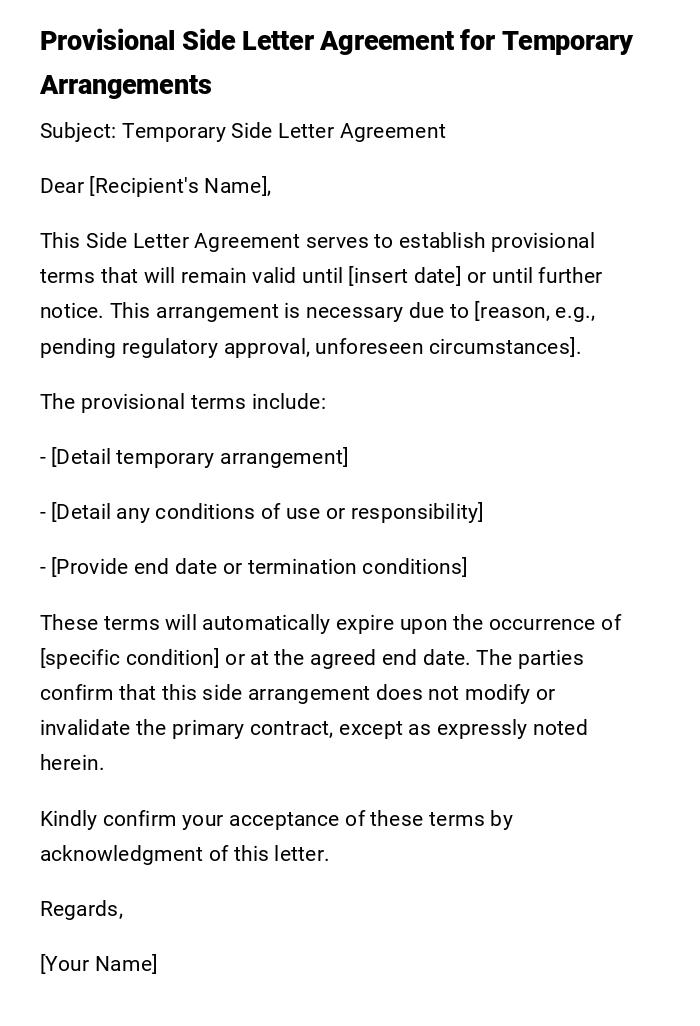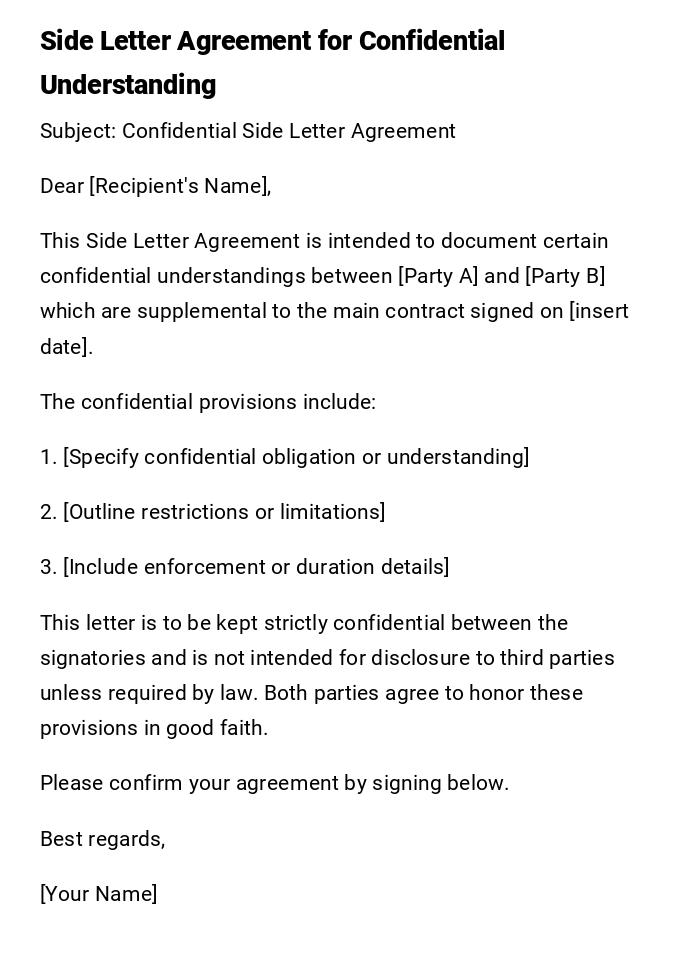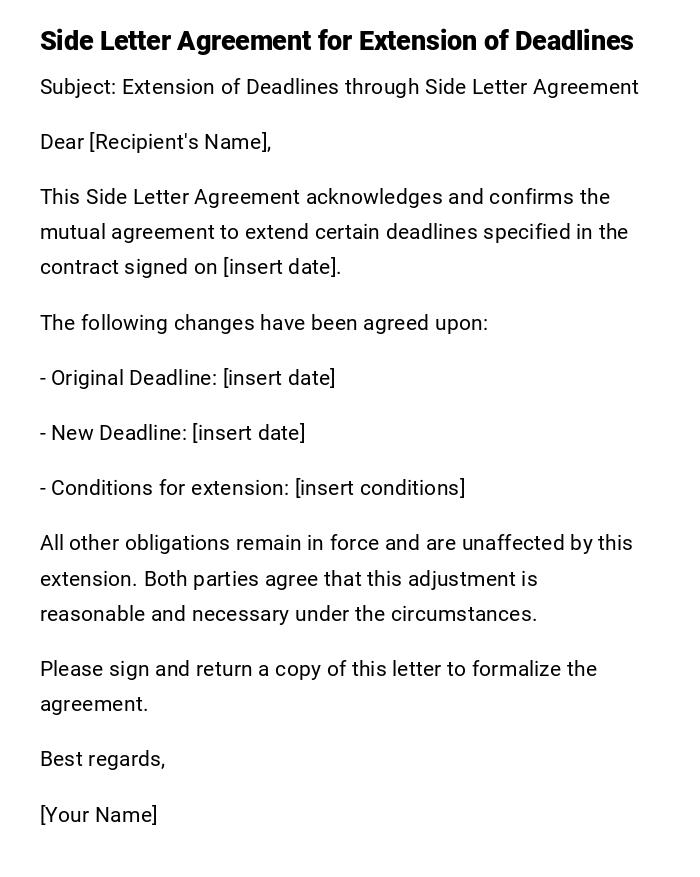Side Letter Agreement
This Side Letter Agreement ("Agreement") is made and entered into on [insert date], by and between [Company A], located at [address], and [Company B], located at [address].
WHEREAS, the parties have entered into a primary contract on [insert date] ("Primary Contract") for the sale of [goods/services] ("Goods");
WHEREAS, after the signing of the Primary Contract, [Company A] has requested an additional quantity of Goods, which was not included in the Primary Contract; and
WHEREAS, the parties wish to modify the terms of the Primary Contract to accommodate the additional quantity of Goods.
NOW, THEREFORE, in consideration of the mutual promises and covenants contained herein, and for other good and valuable consideration, the receipt and sufficiency of which are hereby acknowledged, the parties agree as follows:
Additional Goods. [Company B] agrees to sell and deliver to [Company A] the additional quantity of Goods specified in Schedule A attached hereto.
Price. The price for the additional quantity of Goods shall be [insert price], which is [insert amount] more than the unit price specified in the Primary Contract.
Delivery. The additional quantity of Goods shall be delivered to [Company A] on or before [insert delivery date], in accordance with the terms of the Primary Contract.
Payment. [Company A] shall pay for the additional quantity of Goods in accordance with the payment terms specified in the Primary Contract. [Company A] shall pay the additional amount of [insert amount] upon receipt of the invoice for the additional quantity of Goods.
Effect on Primary Contract. Except as modified by this Agreement, all terms and conditions of the Primary Contract shall remain in full force and effect.
Counterparts. This Agreement may be executed in counterparts, each of which shall be deemed an original, but all of which together shall constitute one and the same instrument.
IN WITNESS WHEREOF, the parties have executed this Agreement as of the date first above written.
[Company A] [Company B]
By: __________________________________ By: __________________________________
Name: _______________________________ Name: _______________________________
Title: _________________________________ Title: __________________________________
SCHEDULE A
Additional Quantity of Goods: [insert quantity]
Unit Price for Additional Goods: [insert price]
Total Price for Additional Goods: [insert amount]
Formal Side Letter Agreement for Clarifying Terms
Subject: Side Letter Agreement Regarding Contractual Obligations
Dear [Recipient's Name],
This Side Letter Agreement (“Agreement”) is executed as a supplement to the primary contract dated [insert date] between [Party A] and [Party B]. The purpose of this letter is to clarify certain terms and provide additional provisions that were not expressly covered in the main contract.
Specifically, both parties agree to the following:
1. [Detail the first clarification or adjustment]
2. [Detail the second clarification or adjustment]
3. [Detail any additional provisions]
All other terms and conditions in the original agreement shall remain in full force and effect. This Side Letter Agreement is binding and enforceable once signed by both parties.
Please review this document carefully and confirm your acceptance by signing and returning a copy.
Sincerely,
[Your Name]
Provisional Side Letter Agreement for Temporary Arrangements
Subject: Temporary Side Letter Agreement
Dear [Recipient's Name],
This Side Letter Agreement serves to establish provisional terms that will remain valid until [insert date] or until further notice. This arrangement is necessary due to [reason, e.g., pending regulatory approval, unforeseen circumstances].
The provisional terms include:
- [Detail temporary arrangement]
- [Detail any conditions of use or responsibility]
- [Provide end date or termination conditions]
These terms will automatically expire upon the occurrence of [specific condition] or at the agreed end date. The parties confirm that this side arrangement does not modify or invalidate the primary contract, except as expressly noted herein.
Kindly confirm your acceptance of these terms by acknowledgment of this letter.
Regards,
[Your Name]
Side Letter Agreement for Confidential Understanding
Subject: Confidential Side Letter Agreement
Dear [Recipient's Name],
This Side Letter Agreement is intended to document certain confidential understandings between [Party A] and [Party B] which are supplemental to the main contract signed on [insert date].
The confidential provisions include:
1. [Specify confidential obligation or understanding]
2. [Outline restrictions or limitations]
3. [Include enforcement or duration details]
This letter is to be kept strictly confidential between the signatories and is not intended for disclosure to third parties unless required by law. Both parties agree to honor these provisions in good faith.
Please confirm your agreement by signing below.
Best regards,
[Your Name]
Side Letter Agreement for Payment Terms Adjustment
Subject: Side Letter Agreement for Payment Schedule
Dear [Recipient's Name],
Following our discussions, this Side Letter Agreement amends the payment schedule outlined in our main agreement dated [insert date].
The revised payment terms are as follows:
- Payment Amount: [insert details]
- Payment Frequency: [insert details]
- Due Dates: [insert details]
- Method of Payment: [insert details]
All other terms of the original contract remain unchanged and fully binding. This letter simply modifies the payment schedule to accommodate both parties’ current needs.
Please review and confirm your acceptance at your earliest convenience.
Yours sincerely,
[Your Name]
Side Letter Agreement for Extension of Deadlines
Subject: Extension of Deadlines through Side Letter Agreement
Dear [Recipient's Name],
This Side Letter Agreement acknowledges and confirms the mutual agreement to extend certain deadlines specified in the contract signed on [insert date].
The following changes have been agreed upon:
- Original Deadline: [insert date]
- New Deadline: [insert date]
- Conditions for extension: [insert conditions]
All other obligations remain in force and are unaffected by this extension. Both parties agree that this adjustment is reasonable and necessary under the circumstances.
Please sign and return a copy of this letter to formalize the agreement.
Best regards,
[Your Name]
Side Letter Agreement for Project-Specific Clarifications
Subject: Project-Specific Side Letter Agreement
Dear [Recipient's Name],
This Side Letter Agreement provides clarification regarding project-specific responsibilities under the main contract dated [insert date].
Clarifications include:
- [Detail responsibility allocation]
- [Provide scope clarifications]
- [State any delivery adjustments]
These clarifications are intended solely for the [project name] and do not affect other projects or aspects of our contractual relationship.
Please confirm acknowledgment and acceptance by signing below.
Regards,
[Your Name]
What is a side letter agreement and why is it needed?
A side letter agreement is a supplemental document that accompanies a main contract. It addresses issues not fully covered in the original agreement or provides clarifications, adjustments, or confidential terms.
Reasons for using a side letter agreement include:
- Adjusting deadlines or payment terms without revising the entire contract.
- Documenting confidential understandings that should not be public.
- Making temporary or provisional arrangements pending future developments.
- Clarifying responsibilities or roles in specific projects.
Who should draft and send a side letter agreement?
- Usually, the party requesting the change or clarification drafts the side letter.
- Legal teams or contract managers prepare it to ensure consistency with the main contract.
- Senior executives or authorized representatives of both parties should review and sign it to make it binding.
- In some cases, an independent mediator or lawyer may draft the letter for fairness.
When do you need to issue a side letter agreement?
Situations where a side letter agreement may be issued include:
- Extending a project deadline due to unexpected delays.
- Adjusting payment schedules to reflect financial circumstances.
- Clarifying scope, responsibilities, or deliverables in a project.
- Recording confidential understandings separate from the main contract.
- Making temporary agreements pending final negotiations.
- Providing flexibility without renegotiating the entire contract.
Formatting and style guidelines for a side letter agreement
- Length: Generally 1–3 pages, depending on complexity.
- Tone: Formal and professional; avoid casual language.
- Structure: Clear subject, specific provisions, signature section.
- Mode of sending: Printed, signed, and exchanged; sometimes sent digitally with e-signatures.
- Wording: Precise and unambiguous, avoiding vague terms.
- Etiquette: Ensure mutual agreement before drafting to prevent misunderstandings.
Common mistakes to avoid in side letter agreements
- Leaving ambiguous language that creates confusion.
- Forgetting to link the side letter clearly to the main contract.
- Omitting signatures from authorized representatives.
- Using informal tone for what is legally binding.
- Failing to clarify whether the side letter overrides or supplements existing terms.
- Not keeping a properly executed copy for records.
Pros and cons of using a side letter agreement
Pros:
- Provides flexibility without revising the full contract.
- Helps address issues quickly.
- Can maintain confidentiality for sensitive terms.
- Allows temporary or provisional solutions.
Cons:
- Risk of inconsistency with the main contract.
- May create enforceability issues if poorly drafted.
- Can cause disputes if one party interprets terms differently.
- Requires careful legal review, adding to cost and time.
Tricks and tips for drafting effective side letter agreements
- Always cross-reference the main contract by date and title.
- State clearly whether the side letter overrides or supplements existing terms.
- Keep the language concise but legally precise.
- Limit the scope to specific issues to avoid confusion.
- Use numbered clauses for clarity.
- Ensure confidentiality provisions are explicit if needed.
- Seek legal review before signing.
Elements and structure of a side letter agreement
A complete side letter agreement should include:
- Subject line for clarity.
- Introduction identifying the main contract.
- Purpose statement explaining why the side letter exists.
- Detailed clauses outlining the adjustments or clarifications.
- Duration/validity if it’s temporary.
- Confidentiality clause if required.
- Signatures from authorized representatives.
- Date of execution to establish enforceability.








 Download Word Doc
Download Word Doc
 Download PDF
Download PDF